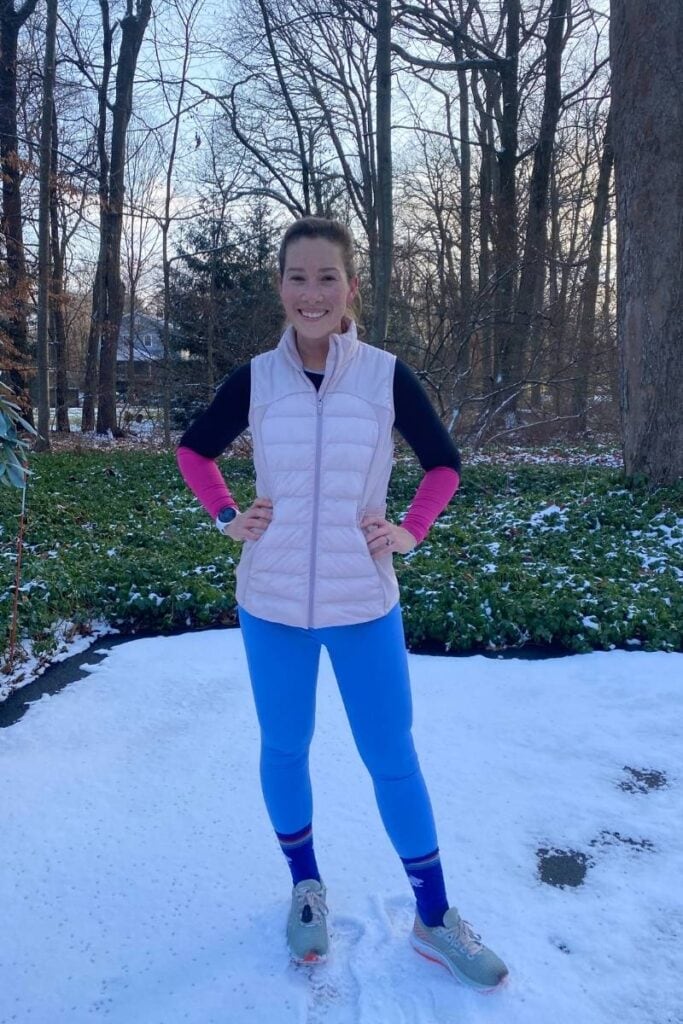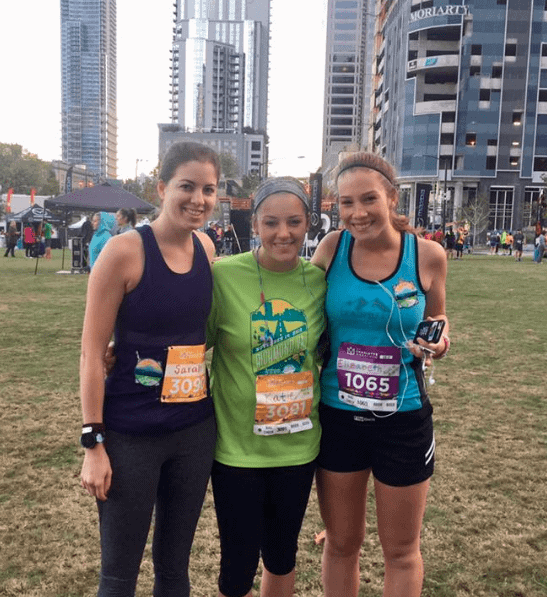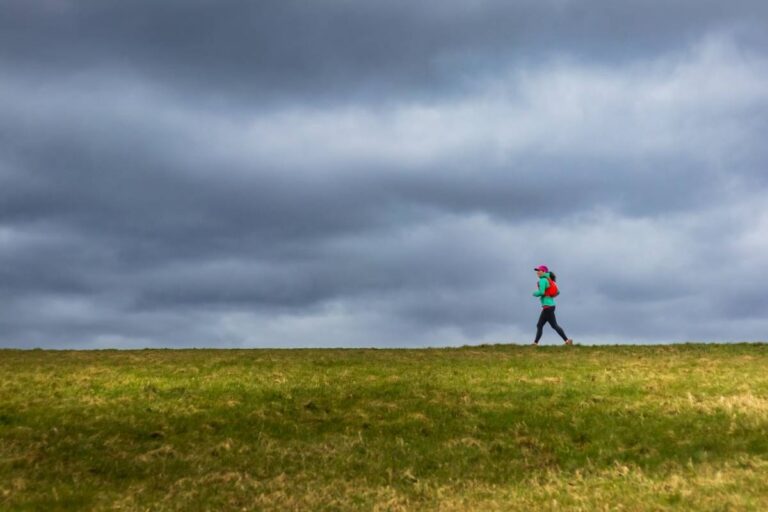What to Wear for Cold Weather Running
Do you enjoy bearing the elements of winter and running outside? Or are you new to the sport and not sure what to wear for cold weather running? Just because it’s winter doesn’t mean you need to be stuck on the treadmill! If you choose the right gear, training through winter is fun, peaceful, and can set you up well to crush your spring goals.
What temperature is too cold for running?
This will vary person to person as everyone has different comfort levels. However, once the temperature gets below freezing be cautious of any exposed skin as frostbite can start to form.
Keep in mind, safety is always the top priority. So, if you find yourself wanting to run outside but don’t have the right gear on hand, jump on the treadmill or move your run to a day when you do have the appropriate gear.
If running in cold weather is new to you, start by running close to your home so you can easily take off (or add) layers as needed. Over time, you’ll learn how you feel in certain temperatures and what gear you like to use. Moreover, just like we do in the summer, run based off your effort, not pace.
Use my Rate of Perceived Effort Guide for guidance on how to run off effort.
What do you wear for cold weather running?
Dress as if it’s 10 degrees warmer than the “feels like” temperature. You’ll want to start your run a little bit cold because you will warm up and sweat. Most importantly, avoid cotton!
Layers:
Thinking broadly, you’ll want to dress in layers when running in the cold. Ideally, these layers should be moisture-wicking fabrics because they’ll trap the heat, keep you warm, and allow sweat to evaporate. Depending on the temperature, you may or may not need all three layers.
1. Base Layer – First, put on a base layer. This will be directly against your skin, so it should be light weight and quick-drying. The EZ Tee LS is a great option and one I wear often.
2. Middle Layer – Over your base layer, you’ll want another lightweight and quick-drying long sleeve. This could be a 1/4 zip, like the EZ Zip.
3. Jacket or Vest – Lastly, when temperatures are frigid, add a third layer. The Athleta Inlet Jacket and the Lululemon Down for It All Vest are perfect options.
Keeping our core warm is essential because it sends blood to our extremities and helps our vital organs and brain function.
Leggings:
You likely won’t need as many layers on your legs as you will for your core. When picking out running tights, thermal running leggings or fleece-lined leggings are the way to go. The Speed Tights are quick-drying and have reflective seams.
Socks:
Personally, I love the Bombas Calf Sock for no skin exposure on colder days. (Cover your ankles!)
What is the best gear for winter running?
Once you’re dressed, think beyond your clothing. While running in cold weather, we not only need to wear clothing that will keep us warm, but gear and accessories to keep us safe.
Goggles:
First, you lose a lot of heat through your eyes! When the weather turns cold, make sure you are covering them with either sunglasses or goggles. The Burton Anon MFI Tech Balaclava Face Mask keeps your face and eyes warm with its fleece and breathable material. Best of all, the face mask and goggles connect via magnet so you have no exposed skin.
If temperatures are above freezing, you may be comfortable just throwing on a pair of Goodr sunglasses.
NANOspikes:
With freezing temperatures comes ice. Unfortunately, running on slippery roads and sidewalks without protection is an injury waiting to happen. Protect yourself by wearing NANOspikes. I’ve been wearing the Kahtoola NANOspikes for five years and feel very safe in them. To put on your shoes, just slip them over your sneaker and the spikes grip the snow and ice. Additionally, Yaktrax makes traction cleats to slip over running shoes.
Headlamp:
If you are running in the predawn or evening hours, wear a headlamp so you’re able to see what’s in front of you. The Petzel Tikkina Headlamp is lightweight with three brightness levels. Moreover, the Black Diamond Headlamp is also lightweight and you can easily adjust the brightness level while running.
Reflective vest:
Not only is it important for you to see when it’s dark out, but you also want to be seen by others. The Noxgear Tracer360 Reflective Vest has multiple colored light options on both the front and back plus reflective straps.
Hat or headband:
Honestly, any wool hat is perfect for the cold weather. The Trailblazer Ponytail Hat covers your ears and has reflective stitching. I’ve been wearing the TrailHeads Ponytail Headband for years and it keeps my ears and forehead warm (and my earbuds in place!).
Gloves or mittens:
No one likes frozen fingers! The Oiselle Super Puff Mittens are insulated and weatherproof to keep your hands warm. Additionally, the Lululemon Run for It All Gloves are another great option as they have a fleece interior and are water-repellent.
Neck warmer or buff:
Chances are, you’ll be hit with some wind while training this winter. To avoid frostbite and windburn, cover your cheeks, nose, and neck with either a neck warmer or buff. Honestly, I wear a Turtle Neck that I also wear when skiing.
How to Dress For Cold Weather Running:
Again, when deciding what to wear for running in cold weather, make sure you check the “feels like” temperature. Below are guidelines for how to dress this winter.
40-50° Fahrenheit (4 to 10° Celsius):
- Base layer
- Shorts or capris
- Sunglasses
- Headlamp and reflective vest if needed
- Gloves, if needed
30-40° Fahrenheit (-1 to 4° Celsius):
- Base layer
- Capris or full length leggings
- Vest
- Hat or headband
- Gloves or mittens
- Sunglasses or goggles
- Headlamp, reflective vest, and NANOspikes, if needed
20-30° Fahrenheit (-7 to -1° Celsius):
Now, the temperature has dropped below freezing. Make sure you cover any exposed skin to reduce the risk of frostbite.
- Base layer
- Running jacket or vest
- Full length leggings
- Calf socks
- Hat or headband
- Gloves or mittens
- Neck warmer or buff
- Sunglasses or goggles
- Headlamp, reflective vest, and NANOspikes, if needed
10-20° Fahrenheit (-12 to -7° Celsius):
Keep in mind, all skin should be covered!
- Base layer
- Middle layer
- Running jacket
- Full length leggings
- Calf socks
- Hat
- Gloves or mittens
- Neck warmer or buff
- Running goggles and face mask
- Headlamp, reflective vest, and NANOspikes, if needed
0-10° Fahrenheit (-18 to -12° Celsius):
Of course, this is very cold. Take caution! Ideally, adjust your run, your effort, and the time you spend outside.
- Base layer
- Middle layer
- Running jacket
- Full length leggings
- Calf socks
- Hat
- Gloves or mittens
- Neck warmer or buff
- Running goggles and face mask
- Headlamp, reflective vest, and NANOspikes, if needed
Sub-zero Fahrenheit (-18° Celsius and colder):
Clearly, this is extremely cold weather. Take extreme caution! Ideally, adjust your run, your effort, and the time you spend outside. If you can, take your run to the treadmill or move it to a warmer day.
- Base layer
- Middle layer
- Running jacket
- Full length leggings
- Calf socks
- Hat
- Gloves or mittens
- Neck warmer or buff
- Running goggles and facemask
- Headlamp, reflective vest, and NANOspikes, if needed
Related Posts:
Interested in Run Coaching?
Looking for guidance with your winter training? I would love to help you! Email me at [email protected] or check out my Run Coaching Services page to learn more.
Comment Below:
Do you enjoy running in cold weather?
What’s your favorite piece of gear for winter running?














